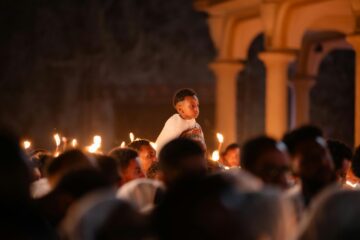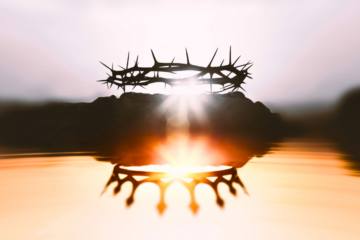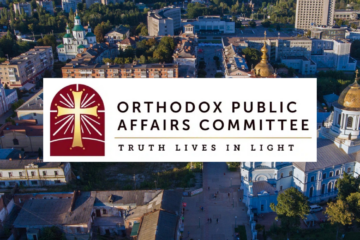Since the New Testament and throughout subsequent generations of believers, “Christ is Risen!” has been at the heart of the Christian proclamation (κ?ρυγμα). It is how Orthodox Christians greet one another during Paschal season. Of all the written testimony about Jesus’ life, in the four Holy Gospels, His death and rising from the dead constitute the heart of the good news (ε?αγγ?λιον). This was the first experience most believers had about the life of the Lord – His death and rising. In effect, the Gospels were constructed “backwards” from the Resurrection of the Lord to the birth and infancy narratives. Ironically, “Christ is Risen!” was first spoken neither by pious priests or bishops, learned lawyers, not by generals or rich merchants. Nor, indeed, did these words even fall first from the lips of Jesus’ male disciples who, being male, were the only ones authorized to give testimony or witness according to Jewish law. The point was moot because these disciples at the time of Jesus’ arrest “had left him and fled away, all of them.” (Mark 14:50) The first heralds of that life-saving and transforming news were the women whom history knows as the Holy Myrrhbearers whose message we hail this coming Sunday. Their lives and bold witness shine forever as beacons of courage in the face of fear, as women possessing a wisdom and innate power of soul that was startlingly divine, as prophetic reminders that the holy gift (χ?ρισμα) of witness and preaching are given to those whom the Lord chooses not on the basis of their gender or position, but because of their loving service and fidelity to Him! The men, after all, had run away. The women stayed to the end and beyond. These holy women are Mary Magdalene, Joanna, Salome, Mary the wife of Cleopas, Susanna, Mary of Bethany, and Martha of Bethany. St. Gregory Palamas and St. Gregory of Nyssa maintain that included in these Myrrhbearing women was Mary, the Theotokos and Mother of the Lord “to whom He would certainly have appeared.” From the earliest Tradition of the Church, these women were known as Equal-to-the Apostles (?σαπ?στολoi) – a distinction given to comparatively few saints in the history of Orthodoxy. These were the “behind the scenes women” in the life of Jesus. While Jesus lived, they washed and anointed His feet, they sat before Him to listen to His words, they served Him meals, they sought His forgiveness, they walked the way of Golgotha, and stood some distance away as their Lord was crucified. Even in death they sought to care for Him. The first individual Myrrhbearer to whom Jesus revealed Himself was Mary Magdalene, from whom he had driven out seven demons, a woman who was sick and restored to health by Him. The Gospel of Mark tells us that the Angel who told the women of Jesus’ rising, also told them to “go tell the Apostles and Peter.” They did and were roundly rejected by them as telling “an old wives tale.” Later, Jesus rebuked these male disciples for their failure to believe and their behavior to the faithful women. What was it about these women that compelled them to rush to preach to the twelve? Why do they stand out in Christian history as “Equal-to-the-Apostles” and what do they teach us who are so far, in time and space, from the cosmic experience of life bursting forth from the stranglehold of sin and of death? The Myrrhbearing Women bore the Spirit of the Risen Christ It was the women who initiated the Apostles into the Mystery of Christ’s Resurrection, not the other way around. The office and ministry of every clergy person in the Church, the heart of their preaching, stems from the ministry and message of these women disciples who directly were filled with the Spirit of the Risen Lord. They were inspired, driven, compelled to tell the story. The Apostles rejected their proclamation as idle tales and thereby proved the women’s point: it will be hard to convert the world to the Risen Christ. They taught the men that they would have to be incredibly reliable witnesses if they ever wanted the world to believe anything that they said. How did these women accomplish this? They were imbued with what the Old Testament calls the “ruach-Yahweh” – the breath of God. The term is the only name for God in Hebrew that is of the feminine gender. It is the same term used in the passage regarding the valley of the dry bones where God calls to the bones: “I will make breath (ruach) enter you, and you will come to life. I will attach tendons to you and make flesh come upon you and cover you with skin; I will put breath in you, and you will come to life. Then you will know that I am the Lord.” (Ezekiel 37:1-14) The noted Scripture scholar, Fr. Joseph Fitzmeyer, referred to this power as “a shaped, purposefully intentional force.” It brought to life, it restored the divine “charge,” it lit the fire in the heart of one who received it and compelled them to action. This was what motivated the Myrrhbearers to preach to their counterparts, regardless of the risk of breaking the Jewish law that said only men are allowed to give legal testimony or witness. Does my faith reflect that kind of “holy excitement”? Is my conviction about Jesus Christ so strong that I can share it with others? Do I, like the male Apostles, run and hide when I am challenged to reorganize my lifestyle for the sake of Christ? Is there fire in my heart for Jesus or has it diminished into a faint flicker? The Myrrhbearing Women were faithful Long before the Myrrhbearers began their trek to the tomb of Jesus, they were by His side. Though oftentimes unseen, they ministered to Jesus during His public ministry – the fed him, washed and anointed his feet, sought various healings from him, attentively listed to His teaching, had Him in their homes and were enthusiastically drawn to Him. It only made sense that they would be “standing a little way” from the Cross as He gave up His last breath. This kind of fidelity and loyalty stood them well and became the context out of which they would “seek the living amongst the dead.” Such faithfulness was called hesed in the Old Testament, translated as “steadfast love.” The relationship of God to His people was characterized as hesed – one of fidelity, loyalty, and faithfulness. This characterized the way the Myrrhbearers related to Jesus and the way Jesus responded to them – by choosing them as the first to announce His Resurrection. Metropolitan Hilarion (Alfayev) stresses the special quality of the women’s fidelity: “The myrrhbearing women are the women who have been building up the Church of Christ during centuries up to the present through their love, labour, and faithfulness to God. There is a power of love of which only women are capable. There is a power of faithfulness and ability to follow Christ that has been inherent in women throughout centuries. The Church cannot exist without this power. There will be no church without it. The ministry and salutary mission of the Church of Christ are impossible without the myrrhbearing women of every age.” How faithful am I to the Lord I profess to follow? Can I say that I actually serve the Lord? Do I remain with Him through good and bad? How can I become more faithful in my life? Does my faithfulness embrace all persons, regardless of religious affiliation, gender, position and status, cultural or ethnic identity, and social grouping? We need to ask ourselves as individuals these reflective questions and the Church as a visible organization charged with preaching that faith needs to ask them of herself as well. The Myrrhbearers, the unexpected proto-heralds of Christ’s rising, challenged the Apostles to move beyond what they thought was impossible, outside of their understanding of “how things have always been” to embrace the Crucified God who had become the Risen Lord of Life. I leave you with a hymn from the Pentecostarion taken from Vespers of the third Wednesday after Holy Pascha. Think upon these words and upon those Holy Women whom St. Ambrose of Milan called “the Apostles’ apostles.”: “Hearing the joyful words of the angel sitting in the tomb of the Word, the women who had run there with good intentions knew that the purpose of their group would be changed. No longer would you carry myrrh! Instead you will preach to the Apostles: “He who was hidden in the earth has risen from hell!” May the Holy Women preachers of the Resurrection intercede for us before the face of God. Christ is Risen! Truly He is Risen!
ABOUT THE ORTHODOX CHRISTIAN NETWORK
Orthodox Christian Network (OCN) is a 501(c)3 and an official agency of the Assembly of Canonical Bishops of the United States of America .It is a recognized leader in the Orthodox Media field and has sustained consistent growth over twenty-two years. We have worked to create a community for both believers and non believers alike by sharing the timeless faith of Orthodoxy with the contemporary world through modern media. We are on a mission to inspire Orthodox Christians Worldwide. Click to signup to receive weekly newsletter.
Join us in our Media Ministry Missions! Help us bring the Orthodox Faith to the fingertips of Orthodox Christians worldwide! Your gift today will helps us produce and provide unlimited access to Orthodox faith-inspiring programming, services and community. Don’t wait. Share the Love of Orthodoxy Today!



0 Comments